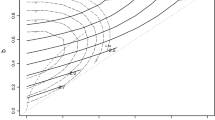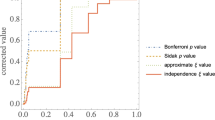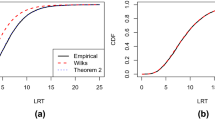Abstract
An analysis of empirical data often leads to a rejection of a hypothesized model, even if the researcher has spent considerable efforts in including all available information in the formulation of the model. Thus, the researcher must reformulate the model in some way, but in most instances there is, at least theoretically, an overwhelming number of possible actions that could be taken. In this paper a “modification index” will be discussed which should serve as a guide in the search for a “better” model. In statistical terms, the index measures how much we will be able to reduce the discrepancy between model and data, as defined by a general fit function, when one parameter is added or freed or when one equality constraint is relaxed. The modification index discussed in this paper is an improvement of the one incorporated in the LISREL V computer program in that it takes into account changes in all the parameters of the model when one particular parameter is freed.
Similar content being viewed by others
References
Aitchison, J., & Silvey, D. C. (1958). Maximum likelihood estimation of parameters subject to restraints,Annals of Mathematical Statistics, 29, 813–828.
BMDP (1977).Biomedical computer programs. Los Angeles: University of California Press.
Bollen, K. A. (1980). Issues in the comparative measurement of political democracy.American Sociological Review, 45, 370–390.
Costner, H. L., & Schoenberg, R. (1972). Diagnosing indicator ills in multiple indicator models. In A. S. Goldberger & O. D. Duncan (Eds.), Structural education models in the social sciences (pp. 167–199). New York: Seminar Press.
Dijkstra, T. K. (1981).Latent variables in linear stochastic models. Unpublished doctoral dissertation, University of Groningen.
Herting, J. R., & Costner, H. L. (1985). Respecification in multiple indicator models. In H. M. Blalock, Jr. (Ed.),Causal models in the social sciences (2nd ed., pp. 321–393). Hawthorne, NY: Aldine.
Holzinger, K., & Swineford, F. (1939). A study in factor analysis: The stability of a bifactor solution.Supplementary Education Monography No.48. Chicago: University of Chicago Press.
Jöreskog, K. G. (1969). A general approach to confirmatory maximum likelihood factor analysis.Psychometrika, 34, 183–202.
Jöreskog, K. G., & Sörbom, D. (1981).LISREL V Analysis of linear structural relationships by maximum likelihood and least squares methods. Chicago: International Educational Services.
Jöreskog, K. G., & Sörbom, D. (1984).LISREL VI Analysis of linear structural relationships by the method of maximum likelihood. Mooresville, IN: Scientific Software.
Keeves, J. P. (1972).Educational environment and student achievement (Stockholm Studies in Educational Psychology No. 20). Stockholm: Almqvist & Wiksell.
Lohnes, P. R. (1979). Factorial modeling in support of causal inference.American Educational Research Journal, 16, 323–340.
MacCallum, R. (1986). Specification searches in covariance structure modeling.Psychological Bulletin, 100, 107–120.
Rao, C. R. (1948). Large sample tests of statistical hypotheses concerning several parameters with application to problems of estimation.Proceedings of the Cambridge Philosophical Society, 44, 50–57.
Saris, W. E., de Pijper, W. M., & Zegwaart, P. (1979). Detection of specification errors in linear structural equation models.Sociological Methodology 1979.
Sörbom, D. (1975). Detection of correlated errors in longitudinal data.British Journal of Mathematical and Statistical Psychology, 28, 138–151.
Author information
Authors and Affiliations
Additional information
The research reported in this paper has been supported by The Swedish Council for Research in the Humanities and Social Sciences under Research Program “Multivariate Statistical Analysis”, Project Director Karl G Jöreskog.
Rights and permissions
About this article
Cite this article
Sörbom, D. Model modification. Psychometrika 54, 371–384 (1989). https://doi.org/10.1007/BF02294623
Received:
Revised:
Issue Date:
DOI: https://doi.org/10.1007/BF02294623




